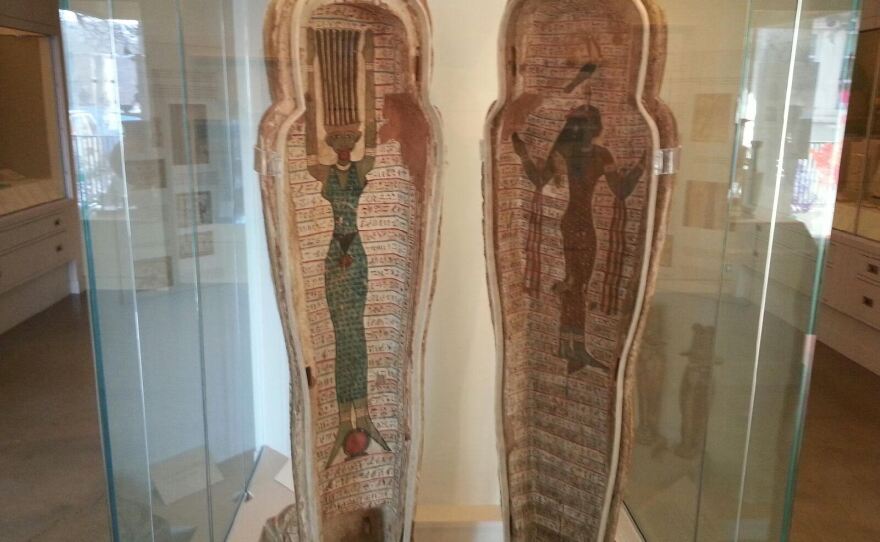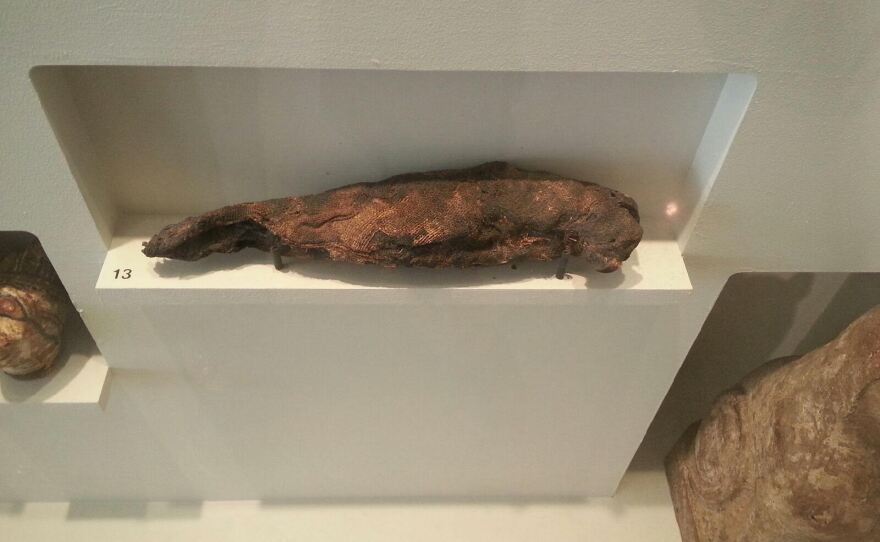You don’t have to travel halfway around the world to see historic artifacts from the ancient world. Treasures have been procured from around the globe and are available for you to see, right in Ann Arbor. Where? It’s a museum on the University of Michigan campus.
You’ll find it clearly visible on State Street, and yet for many, it’s hidden in plain sight.
University of Michigan student Ashley Wade walks by the Kelsey Museum of Archaeology every day. Yet, the two story building that houses historic treasures is a mystery to her. But she’s not alone. Shlomi Avizohal is another student on his way to class. He, too, is unfamiliar with the museum.
"Real Egyptian mummies? Wow, I had no idea again."
The museum has two human mummies--one of them is of a child between two and three years old. It’s tightly wrapped in its original cloth and displayed in an exhibit that looks like a small cave.
Terry Wilfong is the Museum Director. He explains what they learned about the mummy after a CT Scan.
"The mummy has six fingers on one of its hands and that was something that wasn’t clear from older X-Rays that has been done on it. It’s clear that the body was not in good condition when the mummy was wrapped, which suggests that the child had died and hadn’t immediately been buried. And there is a wooden framework in there which did not appear on the X-Rays, which they probably had to tie the body to that to keep it in place during the embalming."
The museum opened in 1928, shortly after the death of its namesake, Francis W. Kelsey. Kelsey was a Professor of Latin at the University of Michigan from 1889 to 1927. In 1924, Kelsey led the school's first archaeological digs in the near Eastern and Mediterranean regions. He brought his findings home to Ann Arbor to use as educational tools.
Once Kelsey had passed, the school created the Museum of Classical Archaeology. In 1953, the museum was named in his honor and later expanded in 2009.
Wilfong explains how they acquired most of the artifacts in the museum.
"About 65% of the objects were acquired through excavation. So we know exactly where things came from. We can pinpoint it down to the room."
The museum houses a collection of more than 100,000 artifacts from countries around the Mediterranean Sea, including Egypt, Greece, and Italy. Most are smaller items and include things like coins.
The majority of the collection is stored in the museum’s basement. The 1,500 larger items on display are chosen based on what the curators believe visitors will enjoy most. That includes cat and bird mummies.
As we continue our walk through the collected gallery, and just steps away from the actual mummies, Wilfong points out another artifact.
"One of the most popular artifacts and one of the most visible artifacts that we have from ancient Egypt is our mummy case. We have a mummy case that belonged to a man named Djehutymose who lived around the year 625 B.C. so about 2,500 years ago. This coffin is covered with text in ancient Egypt hieroglyphics and religious imagery that gives us some idea of what would happen to Djehutymose after he died."
Bright blues, reds, greens, and yellows decorate the coffin of the priest. On the inside of the coffin, the artwork continues with paintings of two Egyptian goddesses. The artist chose to display the goddesses with their arms spread out.
Wilfong says that represents an embrace and eternal protection for the priest.
"This coffin shows us, by the kind of its condition, that there was some sort of accident at the funeral of this man. So they got his mummy embalmed, the coffin would have been made separately, they wanted to put the mummy in the coffin and they discovered it was too big to fit in. So if you see on the edges are places carved out at the shoulders and at the feet. They actually had to carve this out at the funeral in order to get the mummy inside."
While the coffin was donated to the University of Michigan, some artifacts have been purchased, including mummy masks that were influenced by the Greek and Roman cultures.
While these artifacts are displayed in a museum that’s hidden in plain sight, Wilfong says if you look under the display cases, you’ll find more hidden treasures.
"You’ll notice that under some of these cases, there are things with handles on them, they’re drawers. So if you pull out a drawer, you get to see more of these mummy masks and the one in the center of this drawer, this one in particular, is one of the finest pieces that we have. That’s a beautiful plaster cast, plaster mummy mask, very delicately painted. The paint on it is the reason why we can’t display it in the upper case. The pink pigment that covers the shroud that goes around her head is particularly sensitive to light. So it’s kept down in this storage area."
As you can imagine, these treasures require careful preservation. That’s where Suzanne Davis comes in. She’s is the museum's Associate Curator of Conservation. She work's on over 500 artifacts a year. Davis says sometimes in the process, special connections can develop for particular items.
"I worked on a little tiny clay pig, something that a child made in Roman Egypt and I really love that. It really reminded me of toys that my brother and I use to make for ourselves in our backyard growing up in rural Georgia."
About 25,000 people visited the Kelsey Museum of Archaeology last year. Of those, roughly half were students working on school projects. Museum officials say there has been a modest increase in attendance since renovations were made in 2009.
In the near future, they plan to launch a program called “Kelsey in Focus.” It will allow curators to rotate more artifacts through the public display--many of which have never been seen.
Ninety years after it opened, this vault of treasures at the Kelsey Museum of Archaeology, to most, remains hidden in plain sight.
434 South State Street
Ann Arbor, MI 48109
Regular Hours
- Tuesday–Friday: 9 am–4 pm
- Saturday, Sunday: 1–4 pm
- Monday: closed
Admission is free, but donations are welcome.
Non-commercial, fact based reporting is made possible by your financial support. Make your donation to WEMU today to keep your community NPR station thriving.
Like 89.1 WEMU on Facebook and follow us on Twitter
—Jorge Avellan is a reporter for 89.1 WEMU News. Contact him at 734.487.3363 or email him javellan@emich.edu



















